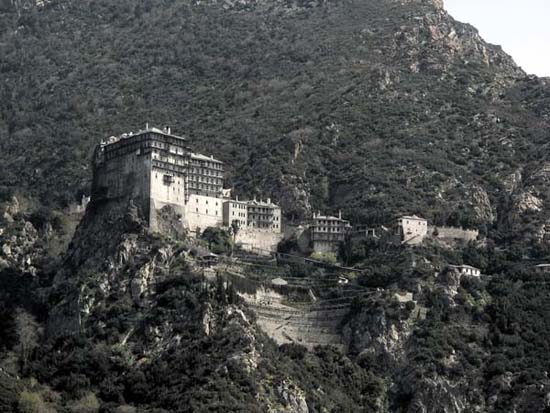A
review for Anglicans Online
by Richard Mammana
Athos
Alive
A review of
Miracle on the Monastery Mountain.
By Douglas Lyttle. Greenleaf Publishing.
2004. See Athosmonasteries.com

I remember with striking clarity the first time I read about Mount Athos. It was in the December 1983 issue of National Geographic magazine, and I was sitting in the waiting room of a doctor's office. Some photographs from that issue that have never left my mind: one of a monk using a chain-saw to cut wood; another of a monk feeding fish (during Lent!) to cats at his feet; a picture of a mosaic icon of (I think) Saint Nicholas with an oyster embedded in the holy bishop's forehead; one of what looked like a dilapidated monastery perched perilously on a mountain; and another photograph, grim and shocking in its depiction of one monk carrying the bleached bones of another in an open wooden box.
Since then, the Holy Mountain has come up in my reading regularly, and I've pored my way through books, magazine and journal articles, video recordings, websites and even microfilms about Athos, its life, structures, inhabitants and history. I have never visited Athos, but I have been inspired and fascinated by the travelogues of others who have done so. Some such accounts—such as Robert Byron's The Station: Athos—Treasures and Men, Athelstan Riley's Athos, or The Mountain of the Monks, or Christopher Merrill's recent Things of the Hidden God—are text-intensive. Others, like the book under review here, rely more heavily on photographs. Douglas Lyttle's massive Miracle on Monastery Mountain is by far the most extensive pictorial account of Athos I have ever seen. Each page measures 12 inches by 12 inches; one really needs an entire coffee table to support it for reading and viewing. It runs to 400 pages, and includes 655 colour illustrations selected from the author's collection of some 50,000 photographs of Athos taken during 22 visits between 1972 and 1998.
Lyttle first travelled to Athos as an Episcopalian at a period when the monastic republic's future was very uncertain. Aging populations of monks inhabited decaying monasteries, and few new men came to join the twenty major monastic foundations or their dependent sketes and hermitages. The miracle of this photographic collection's title is the complete turnaround of Athonite life over the last three decades. Nearly-empty monasteries from the beginning of the narrative are now in many cases full to the seams; large guest wings have been restored, and some modern amenities and technologies have reached the peninsula. (Episcopalian Christopher Merrill's recent account of a visit after the Balkan civil wars of the 1990s reveals that monks sometimes google prospective pilgrims when deciding whether to allow them to visit.) Some things have not changed in the last several decades: the vast treasures of the peninsula—cultural, natural, architectural and spiritual—are intact and well maintained thanks to prominent attention from public figures like the Prince of Wales and the good work of the Friends of Mount Athos as well as grants from the European Union. By all accounts, the monastic stillness of decades ago is still well preserved despite the intrusion of trucks, helicopters and heavy machinery. The renegade monastery of Esphigmenou also still has its flag reading Orthodoxy or Death, and just a small number of pilgrims are allowed within the borders of Athos each day.
During the course of his many visits to Athos, author-photographer Lyttle converted to Eastern Orthodoxy and took the name Demetrios. His career has included 19 years as a pharmaceutical research scientist, 13 years as a teacher at the Rochester Institute of Technology's School of Photographic Arts and Sciences, and 25 years as a documentary travel photographer in Europe, with a primary concentration in Greece. For the vast majority of people who will never visit Mount Athos, photographic work and travelogues like Professor Lyttle's do us a remarkable service. One of the most interesting sections of the book is its ninth chapter, Athos beyond Athos, in which Lyttle photographs Athonite foundations in the United States and the women's monastery of the Annunication of the Mother of God at Ormylia, a convent (with more than 120 nuns) connected with and not too far from Athos itself.
There are more typographical errors in this book than one would like to see, but its real focus is on exquisite photography from one place over an extended period of time. All of my first impressions of Athos from that National Geographic article twenty years ago were enriched immeasurably by this very fine collection. There are cats, icons, monks, relics and monastic buildings in abundance, and Lyttle's skill as a photographer brings them to the page beautifully.
|
R. Mammana is an editor of Anglicans Online. His articles and reviews have appeared in Sobornost, Anglican Theological Review, The Living Church, Touchstone and The Episcopal New Yorker. |